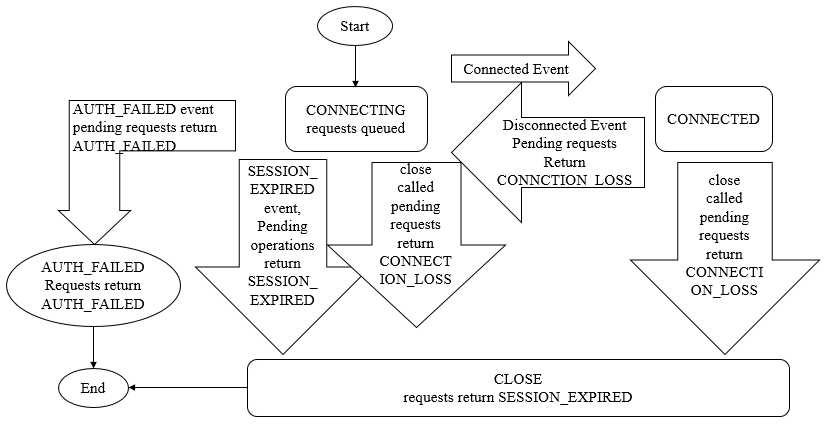Zookeeper源碼閱讀(十二) Seesion(1)
前言
前面三篇主要從client的角度說了下client和server建立連接的過程,這一篇和後面一篇開始看下Zookeeper中非常重要的一個概念:Session,session是zookeeper client和server建立和維護連接的單位(我這個描述感覺有點奇怪 ?? )。
Session狀態
Zookeeper的所有操作基本都是基於session的,如之前提到的wathcer的機制,客戶端請求的順序執行和臨時節點的生命周期。
從我們使用API的角度,session的連接和保持就是客戶端通過實例化Zookeeper對象來與Zookeeper server端創建並保持連接TCP連接的過程。在客戶端與服務器端成功創建了一個連接後,一個會話就被創建了。而在一個會話的生命周期中,session的狀態可能在幾種不同的狀態中切換,而這些狀態可以分為connecting,connected,reconnecting,reconnected,close等。
狀態切換
- 客戶端嘗試去連接服務器端(public ZooKeeper(String connectString, int sessionTimeout, Watcher watcher) throws IOException),這時客戶端回去嘗試連接服務器,而session的狀態就變成了connecting。這個過程之前在講sengthread的部分有詳細講過,具體是client會從server(HostProvider)的列表裏逐個嘗試連接;
- 由於網絡或程序等原因導致服務器和客戶端斷開連接,此時客戶端會嘗試去重新連接server,則session重新進入connecting狀態;
- 重連成功後,session變為connected狀態;
- 會話超時,權限檢查失敗或客戶端主動發起斷開連接請求後session變為close狀態。
p.s. 這裏要提一下第一步,在3.2.0版本中增加了chroot後綴(配置時加在後面,不是說這個chroot的功能是後綴,而且恰恰相反,功能是前綴)的設置,在zk的配置中類似配置 "127.0.0.1:4545/app/a" 或者 "127.0.0.1:3000,127.0.0.1:3001,127.0.0.1:3002/app/a"這樣的設置,那麽在zookeeper上所有的節點前都回家再/app/a的前綴。所以連接後在server上的根節點是/app/a。
作用:This feature is particularly useful in multi-tenant environments where each user of a particular ZooKeeper service could be rooted differently. This makes re-use much simpler as each user can code his/her application as if it were rooted at "/", while actual location (say /app/a) could be determined at deployment time.
Zookeeper官方用下圖來表示狀態的變化:

結合在sendthread介紹中說的,在startconnect方法中連接中會把狀態設置為States.CONNECTING,連接成功後,在Onconnected方法裏會把狀態設置為CONNECTED。
在zk的create/exists/getchildren…等等接口內部最後回去submitRequest並把生成的packet放入queue中,在queuePacket方法的cnLossPacket方法中會根據狀態去處理session超時,驗證失敗和連接丟失的問題。
private void conLossPacket(Packet p) {
if (p.replyHeader == null) {
return;
}
switch (state) {
case AUTH_FAILED://驗證失敗
p.replyHeader.setErr(KeeperException.Code.AUTHFAILED.intValue());
break;
case CLOSED://session超時導致close
p.replyHeader.setErr(KeeperException.Code.SESSIONEXPIRED.intValue());
break;
default://其他原因導致連接丟失
p.replyHeader.setErr(KeeperException.Code.CONNECTIONLOSS.intValue());
}
finishPacket(p);
}在創建Session時,需要設置Session Timeout這個重要參數。這是Zookeeper服務允許一個Session在定義它失效之前的時間。如果服務在時間t內不能看到與一個Session關聯的消息,它將定義這個Session失效。如果客戶端在1/3 t時間內沒有聽到任何從服務器過來的消息,它將發送一個心跳消息給服務器。在(2/3)t時間, Zookeeper客戶端開始尋找另一個Zookeeper服務器,並且它有另外的(1/3)t的時間尋找。
會話創建
實體
public interface SessionTracker {
public static interface Session {
long getSessionId();,
int getTimeout();
boolean isClosing();
}
public static interface SessionExpirer {
void expire(Session session);
long getServerId();
}可以看到,在SessionTracker接口中有兩個內部接口Session和SessionExpirer,可以看到分別和session與session過期有關系。
public static class SessionImpl implements Session {
SessionImpl(long sessionId, int timeout, long expireTime) {
this.sessionId = sessionId;
this.timeout = timeout;
this.tickTime = expireTime;
isClosing = false;
}
final long sessionId;
final int timeout;
long tickTime;
boolean isClosing;
Object owner;
public long getSessionId() { return sessionId; }
public int getTimeout() { return timeout; }
public boolean isClosing() { return isClosing; }
}在SessionTrackerImpl類中有Session接口的實現類,此類也代表了一個真正的session對象。可以看到SessionImpl類中有幾個變量:
sessionId:會話ID,用來標識一個唯一會話。每次客戶端和server連接創建新會話時,zk會為其分別一個全局唯一的ID;
timeout:在創建zookeeper對象時傳入的參數,客戶端向server發送了這個參數後,服務器會根據timeout時間來判斷session的狀態;
ticktime:下次會話超時的時間點,大約為當前時間+timeout,具體之後詳細解釋;
isclosing:表明一個會話是否已經被關閉,如果一個會話已經被標記為closing,server便不會處理來自此session的請求。
SessionId生成策略
在ZookeeperServer的processConnectRequest方法中有對客戶端建立連接請求的處理:
if (sessionId != 0) {//sessionId已經存在
long clientSessionId = connReq.getSessionId();
LOG.info("Client attempting to renew session 0x"
+ Long.toHexString(clientSessionId)
+ " at " + cnxn.getRemoteSocketAddress());
serverCnxnFactory.closeSession(sessionId);
cnxn.setSessionId(sessionId);
reopenSession(cnxn, sessionId, passwd, sessionTimeout);//重新打開session
} else {
LOG.info("Client attempting to establish new session at "
+ cnxn.getRemoteSocketAddress());
createSession(cnxn, passwd, sessionTimeout);//新建session
}long createSession(ServerCnxn cnxn, byte passwd[], int timeout) {
long sessionId = sessionTracker.createSession(timeout);synchronized public long createSession(int sessionTimeout) {
addSession(nextSessionId, sessionTimeout);
return nextSessionId++;//每次取過之後nextSessionId+1
}synchronized public void addSession(long id, int sessionTimeout) {
sessionsWithTimeout.put(id, sessionTimeout);
if (sessionsById.get(id) == null) {
SessionImpl s = new SessionImpl(id, sessionTimeout, 0);//新建sessionImpl對象可以看到在每次新建session是建立在已經保存的nextSessionId的基礎上的。然後看一下nextSessionId的初始化:
public static long initializeNextSession(long id) {
long nextSid = 0;
nextSid = (Time.currentElapsedTime() << 24) >>> 8;
nextSid = nextSid | (id <<56);
return nextSid;
}initializeNextSession方法在zookeeperserver啟動時的startup方法中,startup方法會初始化SessionTrackerImpl變量,此時nextSessionId會被初始化。
這裏用到了Time.currentElapsedTime()方法去獲得當前的時間,是一個64位的值。但是在之前的版本中用的是System.currentTimeMillis() 方法。為什麽要用新的方法替代原來的值,事實上在正常情況下都不會有問題,但是如果有人修改了系統的時間,那麽原來的方法就可能有問題。
至於nextSid生成的算法:系統時間先左移24位然後無符號右移8位然後和myid文件中的唯一id值左移56位生成的值做或操作,這樣可以生產一個64位的唯一ID,然後後面的session基於這個值遞增獲得。這也是為什麽在myid文件中配置唯一id時必須要小於256的原因。
SessionTracker
sessiontracker的作用就是server用來管理會話的,它負責了session的創建,管理和刪除,整個session的生命周期都在sessiontracker的管理之下。每個session在sessiontracker內都分成三份保存。
public class SessionTrackerImpl extends ZooKeeperCriticalThread implements SessionTracker {
private static final Logger LOG = LoggerFactory.getLogger(SessionTrackerImpl.class);
HashMap<Long, SessionImpl> sessionsById = new HashMap<Long, SessionImpl>();
HashMap<Long, SessionSet> sessionSets = new HashMap<Long, SessionSet>();//
ConcurrentHashMap<Long, Integer> sessionsWithTimeout;
long nextSessionId = 0;//下一次session的id
long nextExpirationTime;//最近的超時時間
int expirationInterval;//超時檢查間隔static class SessionSet {
HashSet<SessionImpl> sessions = new HashSet<SessionImpl>();
}sessionsById是根據session的id來管理session實體的屬性;而sessionSets則是根據下次超時時間來歸檔回話,便於會話管理和超時審查;sessionsWithTimeout是線程安全的,它也是按照id來保存session的超時時間,sessionsWithTimeout和zk的內存數據庫相通,會定期同步到快照中。
思考
這一篇主要說了些宏觀的概念和session id的生成機制,比較泛,但是是下一篇的基礎。
參考
https://zookeeper.apache.org/doc/r3.3.6/zookeeperProgrammers.html
https://blog.csdn.net/jeff_fangji/article/details/43916359
https://www.jianshu.com/p/594129a44814
http://www.cnblogs.com/leesf456/p/6103870.html
https://xt00002003.iteye.com/blog/2302392
Zookeeper源碼閱讀(十二) Seesion(1)
